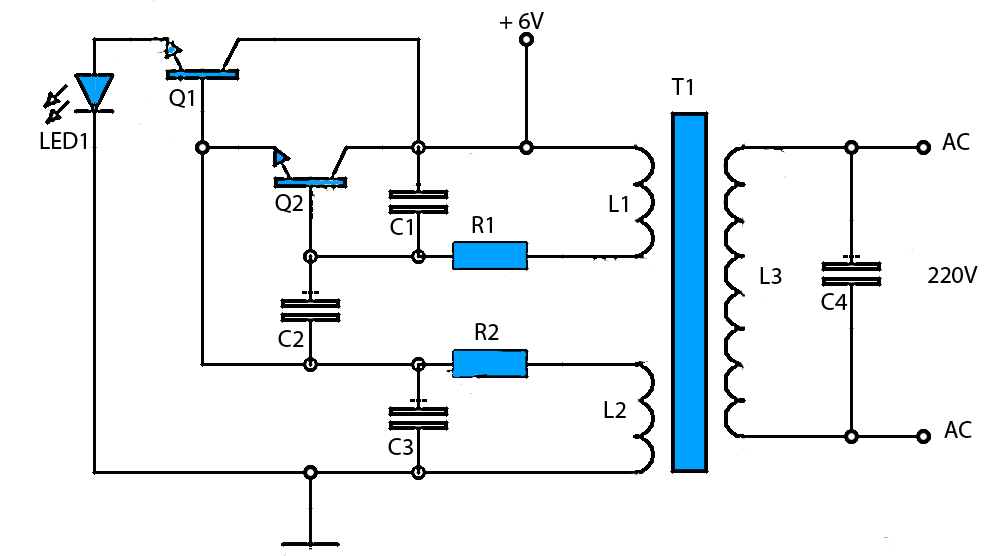
Flash music gyro schematic

The circuit diagram of a flash music gyro consists of three music integrated circuits (IC1: UM66T19L) and multiple light-emitting diodes (LED1 to LED4). During rotation, the centrifugal force activates the centrifugal switch (S1), which powers the four light-emitting diodes, causing them to emit light. Simultaneously, the integrated circuit (IC1) powers a buzzer (BL) to produce music. The centrifugal switch (S) is made from an elastic metal piece that can be adjusted to optimize performance. Additionally, since the gyro is a rotating body, maintaining overall balance is crucial. Therefore, the layout of the printed circuit board (PCB) must be symmetrical and consider weight distribution in the vertical direction.
The flash music gyro circuit integrates multiple components to create an engaging visual and auditory experience. The main component, the UM66T19L integrated circuit, is designed to generate musical tones when powered. This IC is connected to a buzzer (BL), which converts electrical signals into sound, producing music that complements the visual effects generated by the LEDs.
The light-emitting diodes (LED1 to LED4) serve as the primary visual output of the circuit. These LEDs are arranged to emit various colors and patterns, enhancing the overall aesthetic of the device. The activation of these LEDs is controlled by a centrifugal switch (S1), which responds to the rotational motion of the gyro. As the gyro spins, the centrifugal force causes the switch to close, allowing current to flow to the LEDs and the buzzer, creating a synchronized light and sound display.
The centrifugal switch is constructed from an elastic metal piece, which can be adjusted to fine-tune the activation threshold. This adjustability is essential for ensuring that the device operates correctly under varying conditions, such as different rotational speeds. The design of the switch plays a critical role in the responsiveness of the system to changes in motion.
In addition to the functional components, the design of the printed circuit board (PCB) is vital for the performance of the flash music gyro. The PCB layout must be symmetrical to ensure that weight is evenly distributed, which is crucial for maintaining balance during rotation. An unbalanced PCB can lead to erratic motion, which may affect the operation of the centrifugal switch and the overall performance of the device.
Careful consideration of component placement and PCB design will result in a robust and reliable flash music gyro circuit capable of delivering both captivating light shows and engaging musical experiences. Proper engineering practices will ensure that the device operates efficiently and effectively, providing users with a delightful interaction through its visual and auditory outputs. As shown in the circuit diagram of a flash music gyro, which is composed of three end music integrated circuits ICl UM66T19L a variety of colors and light-emitting diodes LEDl ~ LED4 composition. Gyro during rotation, due to centrifugal force, centrifugal switch Sl is turned on, the power is directly applied to four light-emitting diodes to emit light. At the same time ICl also powered buzzer BL emit the sound of music. Centrifugal switch S available elastic metal piece made several adjustments and the need to achieve better results.
In addition, since the gyro is a rotating body motion, the overall balance is very important. Therefore, the layout of the printed circuit board not only pay attention symmetrical, taking into account the balance of weight in the vertical direction.
The flash music gyro circuit integrates multiple components to create an engaging visual and auditory experience. The main component, the UM66T19L integrated circuit, is designed to generate musical tones when powered. This IC is connected to a buzzer (BL), which converts electrical signals into sound, producing music that complements the visual effects generated by the LEDs.
The light-emitting diodes (LED1 to LED4) serve as the primary visual output of the circuit. These LEDs are arranged to emit various colors and patterns, enhancing the overall aesthetic of the device. The activation of these LEDs is controlled by a centrifugal switch (S1), which responds to the rotational motion of the gyro. As the gyro spins, the centrifugal force causes the switch to close, allowing current to flow to the LEDs and the buzzer, creating a synchronized light and sound display.
The centrifugal switch is constructed from an elastic metal piece, which can be adjusted to fine-tune the activation threshold. This adjustability is essential for ensuring that the device operates correctly under varying conditions, such as different rotational speeds. The design of the switch plays a critical role in the responsiveness of the system to changes in motion.
In addition to the functional components, the design of the printed circuit board (PCB) is vital for the performance of the flash music gyro. The PCB layout must be symmetrical to ensure that weight is evenly distributed, which is crucial for maintaining balance during rotation. An unbalanced PCB can lead to erratic motion, which may affect the operation of the centrifugal switch and the overall performance of the device.
Careful consideration of component placement and PCB design will result in a robust and reliable flash music gyro circuit capable of delivering both captivating light shows and engaging musical experiences. Proper engineering practices will ensure that the device operates efficiently and effectively, providing users with a delightful interaction through its visual and auditory outputs. As shown in the circuit diagram of a flash music gyro, which is composed of three end music integrated circuits ICl UM66T19L a variety of colors and light-emitting diodes LEDl ~ LED4 composition. Gyro during rotation, due to centrifugal force, centrifugal switch Sl is turned on, the power is directly applied to four light-emitting diodes to emit light. At the same time ICl also powered buzzer BL emit the sound of music. Centrifugal switch S available elastic metal piece made several adjustments and the need to achieve better results.
In addition, since the gyro is a rotating body motion, the overall balance is very important. Therefore, the layout of the printed circuit board not only pay attention symmetrical, taking into account the balance of weight in the vertical direction.





